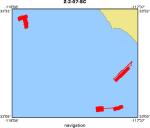|
|
|
Metadata
|
|
ID
|
Z-2-07-SC
|
|
Also Known As
|
MBARI ID 290
Dana Point Exped.
|
|
Abstract
|
Monterey Bay Aquarium Research Institute,United States
Geological Survey, Menlo Park, California. Chirp and
Multibeam Sonar data of field activity Z-2-07-SC in Offshore
Orange County, CA from 07/09/2007 to 07/16/2007
|
|
Organization
|
Monterey Bay Aquarium Research Institute
United States Geological Survey, Menlo Park, California
|
|
Project/Theme
|
Gas Hydrates
|
|
Activity Type
|
Chirp and Multibeam Sonar
|
|
Platform
|
Zephyr
|
|
Area of Operation
|
Offshore Orange County, CA
|
|
Location map
|

|
|
Bounding Coordinates
|
33.50748
-118.10279 -117.63450
33.17458
|
|
Ports
|
LEAVE Moss Landing, CA
ARRIVE Moss Landing, CA
|
|
Dates
|
07/09/2007 (JD 190) to 07/16/2007 (JD 197)
|
|
Analog Materials
|
No analog holdings.
|
|
Index map

|
|
|
Information Specialist
|
|
|
Crew
|
|
David Caress
|
Chief Scientist, MBARI
|
|
Ray Sliter
|
Scientist, USGS
|
|
Hans Thomas
|
AUV operations, MBARI
|
|
Doug Conlin
|
AUV operations, MBARI
|
|
Aaron Gregg
|
Zephyr crew (Master), MBARI
|
|
Matthew Noyes
|
Zephyr crew (Engineer), MBARI
|
|
Paul Ban
|
Zephyr crew (Mate), MBARI
|
|
Perry Shoemake
|
Zephyr crew (Mate), MBARI
|
|
|
Purpose
|
|
Six AUV dives planned in the California
|
|
Borderland, located offshore between Newport, CA and San Mateo Point.
|
|
Three primary targets: 1) Deformed sediments over the San Mateo Thrust west of
|
|
San Mateo Point; 2) Palos Verdes Fault Zone/ San Gabriel Canyon west of
|
|
Newport; 3) area near Coronado Bank Fault zone, faulted strata and possible
|
|
hydrate target. The areas mapped are in water depths of 250 to 850 m. The
|
|
primary objective of these dives is to obtain multibeam bathymetric data and
|
|
high-resolution subbottom profiles. Processing and analysis of this data will
|
|
be used to identify target sites for core sampling related to active faulting
|
|
in order to determine the time of the most recent fault movement and for
|
|
sedimentary architecture related to methane gas discharge and hydrate formation.
|
|
|
Summary
|
|
Local times used; (July 9 JD 190)
|
|
|
~1700/JD190 R/V Zephyr departs Moss Landing.
|
|
|
~2100/JD191 R/V Zephyr arrives Ocean Institute, Dana Point.
|
|
|
~1534/JD192 Begin first AUV dive off of San Mateo Point
|
|
|
~1756/JD192 Abort first AUV dive off of San Mateo Point
|
|
|
~2137/JD192 Begin second AUV dive off of San Mateo Point
|
|
|
~0651/JD193 End second AUV dive off of San Mateo Point
|
|
|
~1241/JD193 Begin third AUV dive off of San Mateo Point
|
|
|
~2123/JD193 End third AUV dive off of San Mateo Point
|
|
|
~0354/JD194 Begin first AUV dive over Palos Verdes Fault
|
|
|
~1232/JD194 End first AUV dive over Palos Verdes Fault
|
|
|
~1832/JD194 Begin second AUV dive over Palos Verdes Fault
|
|
|
~0330/JD195 End second AUV dive over Palos Verdes Fault
|
|
|
~1328/JD195 Begin first AUV dive over suspected methane hydrate occurrences
|
|
|
~2227/JD195 End first AUV dive over suspected methane hydrate occurrences
|
|
|
~0345/JD196 Begin second AUV dive over suspected methane hydrate occurrences
|
|
|
~1245/JD196 End second AUV dive over suspected methane hydrate occurrences
|
|
|
~1500/JD196 R/V Zephyr returns Ocean Institute, Dana Point.
|
|
|
~1530/JD196 R/V Zephyr departs Ocean Institute, Dana Point.
|
|
|
~1900/JD197 R/V Zephyr arrives in Moss Landing
|
|
|
A total of 6 AUV dives were successful and one was aborted. The first dive was
|
|
aborted because the AUV was erroneously programmed to ascend for a GPS fix
|
|
after every line. The AUV's starting position was determined by GPS at the
|
|
launch site. The vehicle then dives in a USBL-nav-aided spiral to 50 meters
|
|
above the seafloor. The AUV can survey with the multibeam sounding system and
|
|
chirp sonar for ~9 hours; it then returns to the sea surface to be picked by
|
|
the R/V Zephyr. All three of the planned surveys (all six dives) were
|
|
completed. A typical AUV dive will result in 35 to 40 km of survey trackline
|
|
with a line spacing of 150 m. The total survey trackline for the Borderland
|
|
operation was approximately 250 km.
|
|
|
Notes
|
|
MBARI's automated underwater vehicle (AUV) for sea-floor mapping and
|
|
subbottom profiles. The AUV has a high-resolution Edgetech chirp sonar
|
|
profiling system and a multibeam sounding system and uses both Doppler sonar
|
|
tracking of the sea floor and an inertial guidance system for position
|
|
control. The AUV descends to 50 m above the seafloor with USBL-nav-aided spiral descent.
|
|
|
Got Help?
|
For Z-2-07-SC, we would appreciate any information on -- analog materials, chief scientist, contract, days at sea, dive count, equipment used, funding, information to be derived, kms of navigation, national plan, NGDC Info, owner, project number, publications, scanned materials, seismic description, station count, station description, submersible, tabulated info.
|
|






